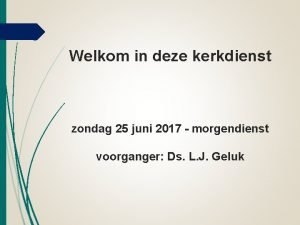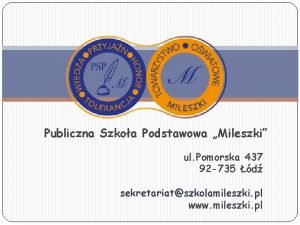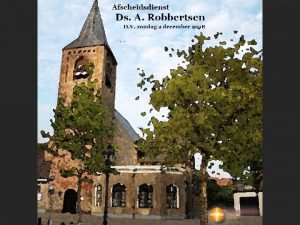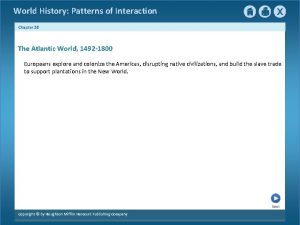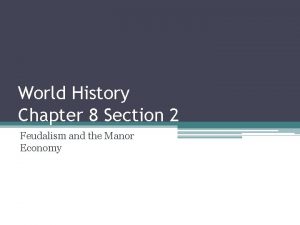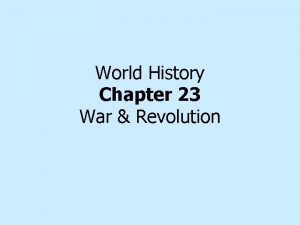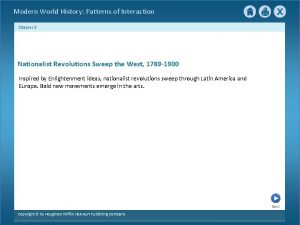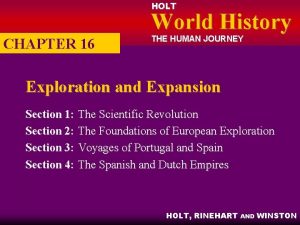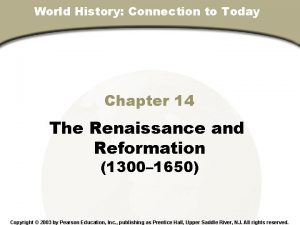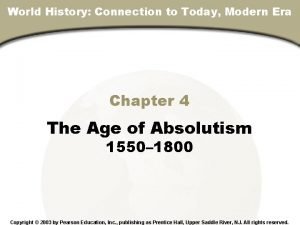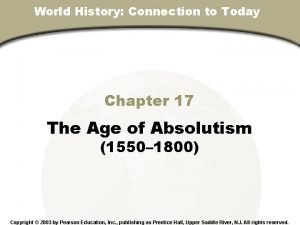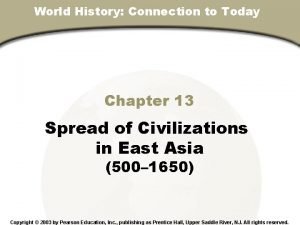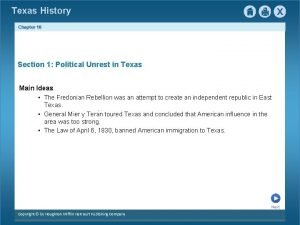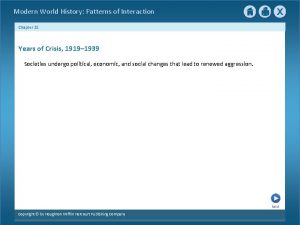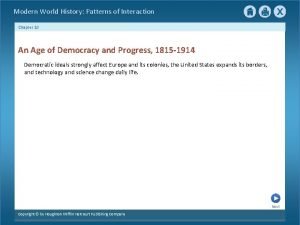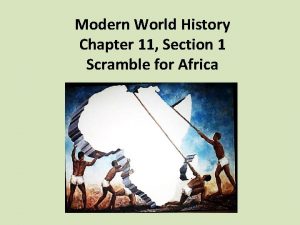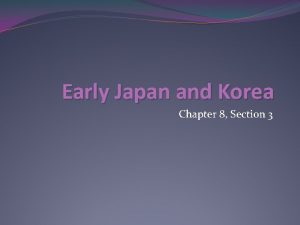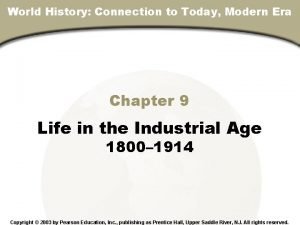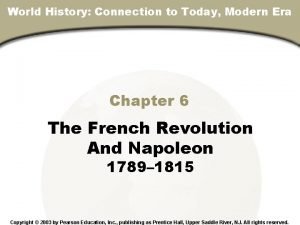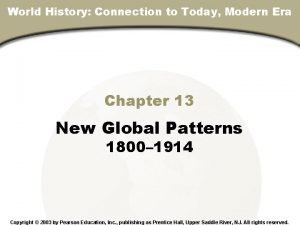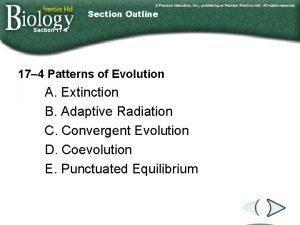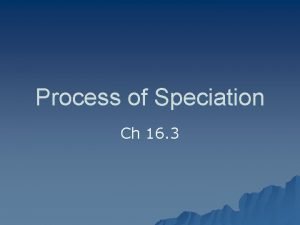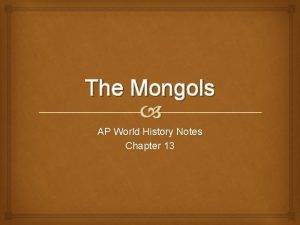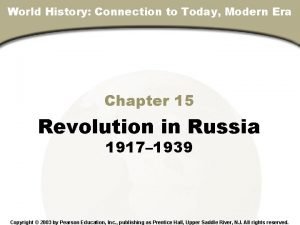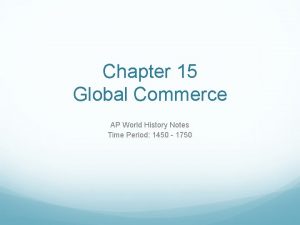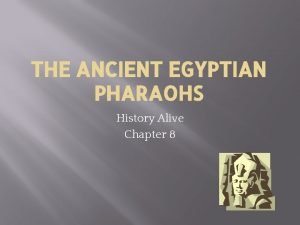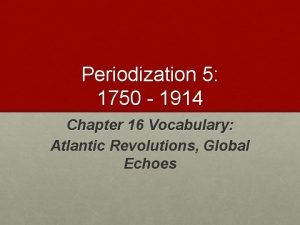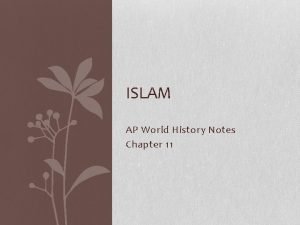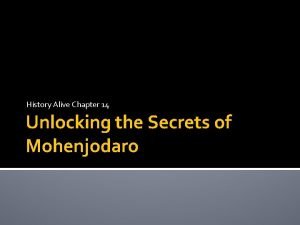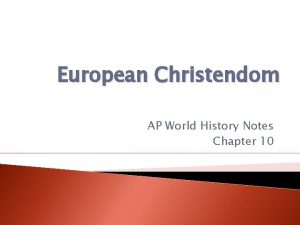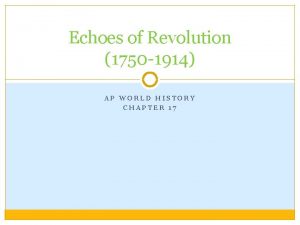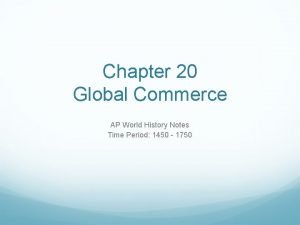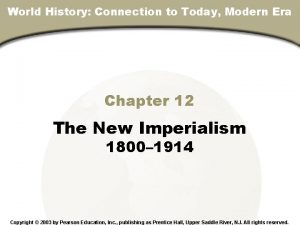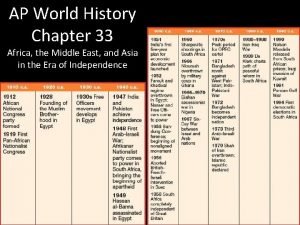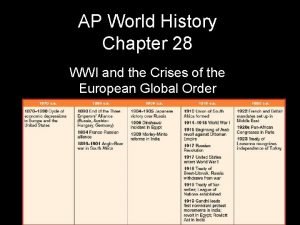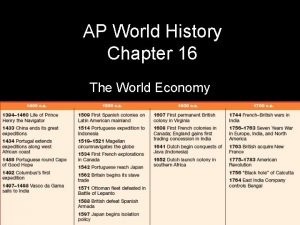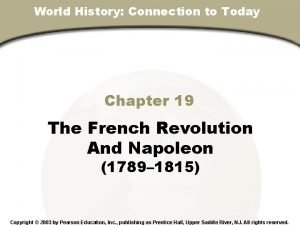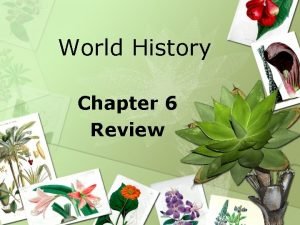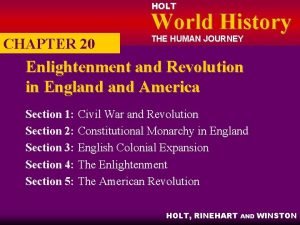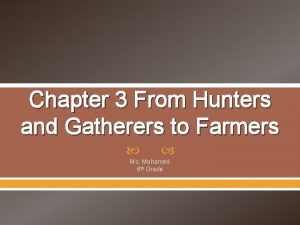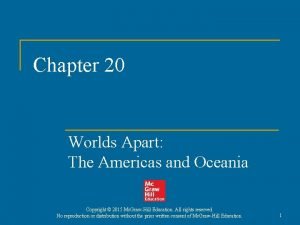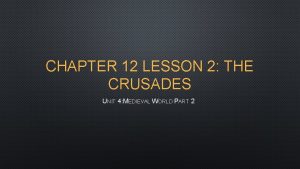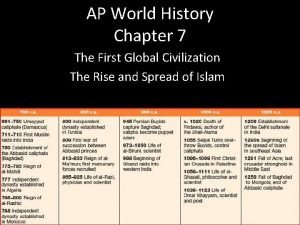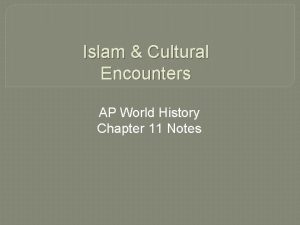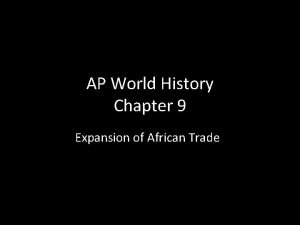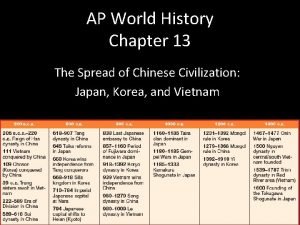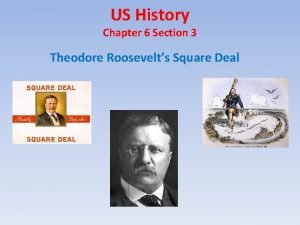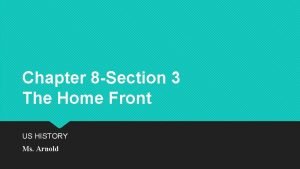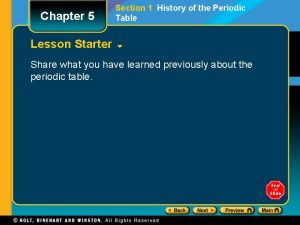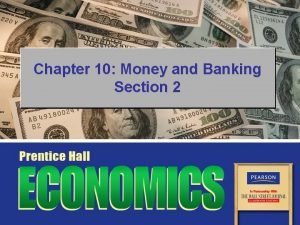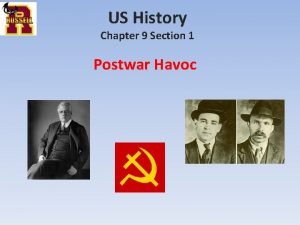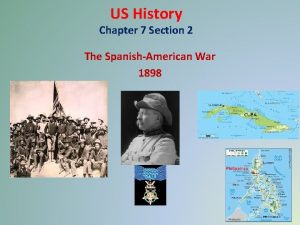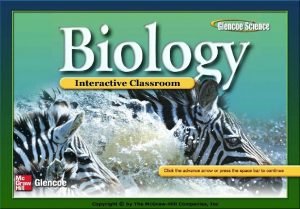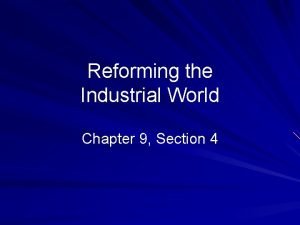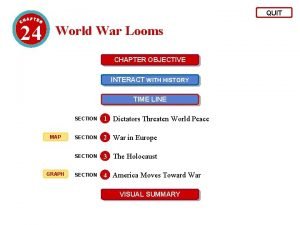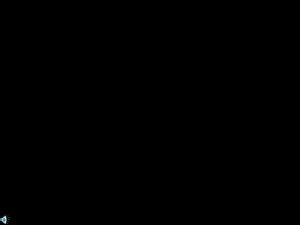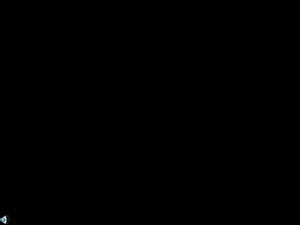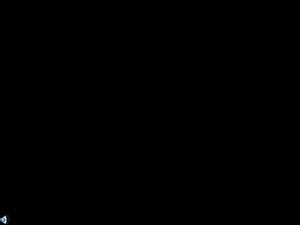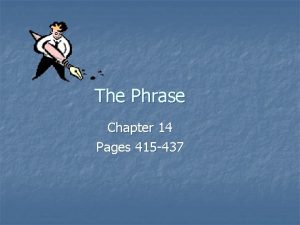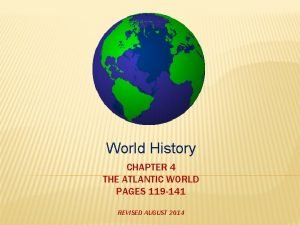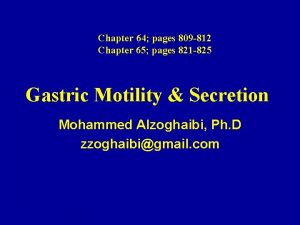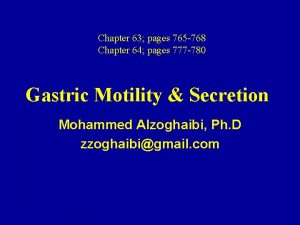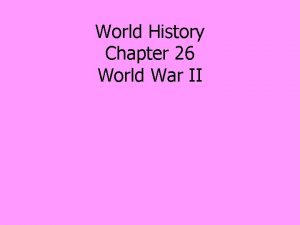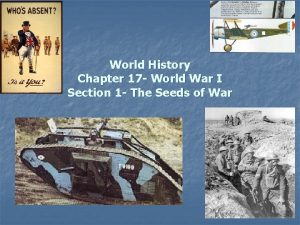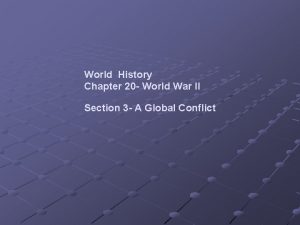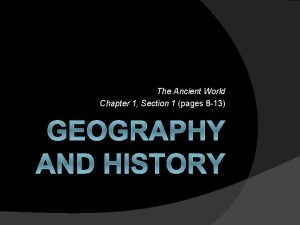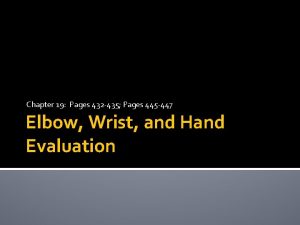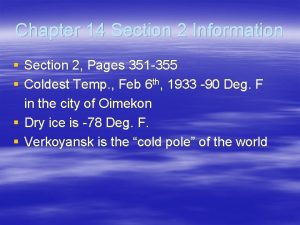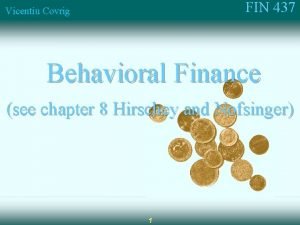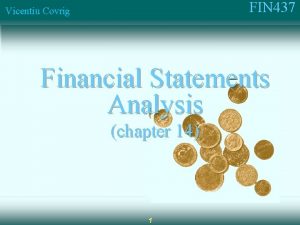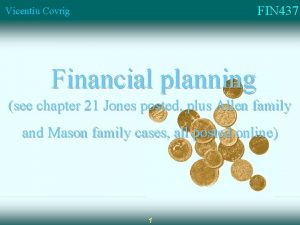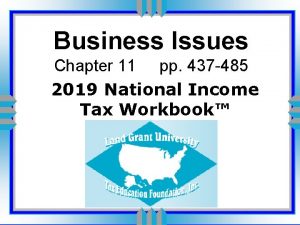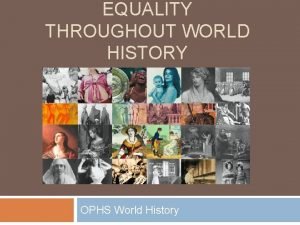World History Chapter 15 Section 1 Pages 437
































































- Slides: 64

World History Chapter 15 Section 1 Pages 437 -443 Revised August 30, 2012

1. Who was Michelangelo? What is he famous for? n Famous artist during the Italian Renaissance. n Painting on the ceiling of the Sistine Chapel in Rome, Italy. His Christian-inspired view of God creating the stars and planets is only a part of the ceiling. n It took him over four years to complete his masterpiece. n He often was on 60 foot scaffolding. n

2. What changes in society and in cities stimulated the beginning of the Renaissance? n The Black Death, starvation, and warfare had overtaken Europe about 1300. n These catastrophic events and the enormous loss of life may have led to some of the changes of the 1300 s. n These changes included: n Growth of important city-states n Increased trade n New wealth

Section 1 – The Italian Renaissance 1300’s- Black Death, starvation, warfare, caused many changes throughout Europe: Decrease in population allowed farmers to produce more food than needed. v Food prices declined- Money could be spent on other things- SUPPLY AND DEMAND v Agricultural Specializationv v v England- wool Germany- Grain Specialization led to TRADE v Regions had to trade for the products they did not produce. THE RISE OF CITY-STATES v Northern Italy became centers of COMMERCE v Venice, Milan, and Florence Bankers, Traders, Skilled workers or artisans v Knowledge of the Arts v v v Nobles wanted different ways to display their wealth Paintings, sculpture, and architecture

3. What was the Renaissance? Where did start? Why? n Changes in the economy and social structure led to a sustained period of renewed interest in art, literature, science, and learning. n Arose in Italy had thriving cities, increased trade, and a wealthy merchant class.

Section 1 – The Italian Renaissance = rebirth of philosophy & art n Early 1300 s n Renewed interest in Greek/Roman culture n Emphasis on power of human reasoning

4. What was humanism? Where did it come from? n The renewed interest in ancient Greek and Roman culture gave rise to an increased education. This interest led to the classic teaching of grammar, poetry, history, and Latin/Greek. n These subjects became known as humanities, thus this movement is called humanism. n

Renaissance n Humanists – people who studied the humanities Grammar, history, poetry, rhetoric n Included: n Dante Alighieri, Giovanni Boccaccio, and Francisco Petrarch n Their views: n Emphasized education n Wanted to understand how things worked n Become actively involved n Felt tension between studies and religion (Catholics) n Admired individual achievement n

5. List the six causes of the Renaissance. n Increased trade n Growth of city-states n Renewed interest in classical learning n Rise of rich and powerful merchants n Increased desire for scientific knowledge n Desire to beautify cities

Section 1 – The Italian Renaissanc. E n Secular- Worldly rather than spiritual focus. n Universal Man- Accomplished in the classics, but also a man of action. Such a man could respond to all situations. Individual achievements and education were important!

6. What ideas formed the foundation of the Italian Renaissance? n Inspiration from the ancient Greeks and Romans n Humanism n Secular forces

Italian Renaissance Writers n Francesco Petrarch n n (PEE trahrk) His sonnets considered greatest in history Studied the classical writers (Greek & Romans – classical education) Wrote literature in the vernacular, or everyday language of the people. Worried his desire for fame contradicted his salvation

Italian Renaissance Writers (cont. ) n Niccolo Machiavelli (mahk yah VEL lee) n Political philosopher and statesman n n Described government by the way it actually worked (not in lofty ideals) Believed in ruthless behavior to get ahead – “Machiavellian” Better to be feared than loved as a ruler Wrote “The Prince” n Baldassare Castiglione (kahs teel YOH nay) n Most famous book of Renaissance – “The Book of the Courtier” n Showed how gentlemen/gentlewomen should act in polite society

7. What suggestions were made on how gentlemen and gentlewomen should behave? n Speak of serious subjects as well as amusing ones. n Have a knowledge of Latin or Greek n Be well-acquainted with poetry and history n Be able to write prose as well as poetry

8. How did science influence the Renaissance? n Humanists discovered a wealth of scientific information from archives and Arab translations for classical texts. n These new ideas about the natural world were beginning to be explored. n Thus, challenging the church’s teachings about the world.

SCIENCE DURING THE RENAISSANCE n A wealth of scientific information was added during the Renaissance. Many times this information would challenge religious beliefs. n Nicholas Copernicus- Polish astronomer, suggested that the Sun was the center of the universe. n Galieleo Galilei- Italian astronomer who wrote that the Earth orbited the Sun was punished by the Church

9. What contributions did artists make to the Renaissance? n New styles and techniques n Focus on human personality n Works inspired by Greek and Roman art

Renaissance Art n Used realistic scenes/images – lifelike n Perspective –technique to make paintings lifelike n Illusion of depth – distant objects smaller than foreground objects

Italian Renaissance Artists n Leonardo da Vinci n Talented (painter, architect, engineer, scientist, drawings of flying machine and submarine) n Drew realistic human figures n “The Last Supper” and “Mona Lisa”

Italian Renaissance Artists (cont. ) n Michelangelo n Brilliant painter n Sistine Chapel of the Vatican (Pope’s home) n “David”- sculpture of biblical figures n Helped design St. Peter’s Basilica in Rome Sistine Chapel “David” St. Peter’s Basilica

Italian Renaissance Artists (cont. ) n Raphael Sansio n Renowned painter and accomplished architect n Helped beautify Vatican n Known for paintings of Virgin Mary Donato Bramante q Chosen architect of Rome q Design for St. Peter’s Basilica influenced the design of smaller churches q

Michelangelo(left) Da Vinci (right) The Last Supper Sistine Chapel The Pieta – (Virgin Mary with Jesus) David The Creation of Man Mona Lisa Baptism of Christ

THE NORTHERN RENAISSANCE n Section 2 n (pages 444 -448)

1. How did the Renaissance spread to northern Europe? In the 1200 s and 1300 s, most cities in Europe were in Italy. By the 1500 s, however, large cities had also sprouted in northern Europe. Cities like London, Paris, and Amsterdam. Trade and the Hanseatic League. The Hanseatic League was a merchant organization that controlled trade throughout Northern Europe- 1200 -1400. Also worked to protect its members from pirates and other hazards. Trade led to the exchanging of ideas. Travel. Many Renaissance artists moved north Some Northern artists traveled to Italy for an education Others escaped to avoid violent clashes between the armies of northern monarchs and the wealthy Italian cities. The Printing Presshelped to spread ideas with printed material.

2. Who is credited for inventing the printing Press? n Johannes Gutenberg – 1450 – used movable type to print books n Roots were in China and Korea n Movable type allowed text to be quickly printed on both sides of the paper n Hand writing was long and tedious n Printing helped pass ideas on faster n Gutenberg Bible (1282 pages)

3. What were the effects of the printing press on society? n Printing press invented n Press technology spreads n Easier and cheaper to make books n More books available n Ideas spread quickly n People want to learn to read

“Haters” of Print n Not all Europeans liked Gutenberg’s print n Reasons: n 1. books printed on paper did not last long n 2. Less beautiful than hand printed n 3. put hand copying scribes out of work n Nonetheless, Gutenberg’s printing press spread

4. Who was Desiderius Erasmus? (i RAZ muhs) n Desiderius Erasmus n Criticized church’s lack of spirituality Wanted return of the simple message of Jesus n “The Praise of Folly” – book ridiculed ignorance and superstition among Christians. Also criticized fasting, pilgrimages, shrines n

5. Who was Thomas More? n Thomas More n Published “Utopia” n Said governments were corrupt n Against private ownership of property n Executed after refusing to agree that King Henry VII was head of the church n Later made a saint by Catholic Church

6. Who was William Shakespeare? n William Shakespeare n Wrote “Hamlet”, “Romeo & Juliet, ” “Macbeth” n Portrayed personality and human emotions n Most widely known author of this time period.

7. What contributions did writers and philosophers make to the northern Renaissance? n Fanned the flames of discontent with the Catholic Church. n Introduced humanism to England. n Spread Renaissance ideas to a mass audience.

8. Who were some of the famous artists of the northern Renaissance? n Albrecht Durer (DOOR-uhr) n German artist n Painted in oils n Jan van Eyck n Area of the Netherlands n Flemish school n Also used oils to depict landscapes and domestic life n Hans Holbein n German artist

9. How did the works of northern artists differ from those of the Italian Renaissance? n Northern artists tried to depict things as they actually were, more realistic. n Italian Renaissance Capture the beauty of Greek and Roman gods. n Mythological scenes. n

Section 3 – The Protestant Reformation n Pages 449 -454

1. What was the Protestant Reformation? n Reformation – Religious revolution that split the church in Western Europe – 1517 n n Some thought church too interested in money Clergy acted as politicians instead of moral leaders Northern humanists sought emphasis on faith Catholic church ignored their concerns

2. What was the state of Catholicism in the 1400 s? n Church was wealthy and powerful. n Involved in politics. n Had moved away from spiritual roots. n Often financially corrupt and taxed unfairly. n The middle class and peasants were taxed heavily.

3. Who were the early reformers and what happened to them? n John Wycliffe English n Believed the church should give up its earthly possessions n Removed from teaching position. n Jan Haus n Priest n Preached against the immorality of the Catholic Church n Excommunicated n Arrested, tried and convicted of heresy n Burned at the stake n

The Beginning n In Germany n Made up of 300 independent states – weak rulers n Monk Johann Tetzel – selling indulgences n This created opposition in northern Germany by humanists

4. What was the “sale of indulgences”? n Indulgences were pardons issued by the pope that people could buy to reduce a soul’s time in purgatory. n For many Catholics, the belief was for a dead person to work off the sins they had committed in purgatory. n The sale of indulgences was highly criticized by many people.

5. How did Martin Luther challenge the Catholic Church? n Wrote Ninety Five Theses n Claimed Christ was the only head of the Church n Salvation was done by faith alone, not indulgences. n Questioned basic beliefs of Catholicism.

Martin Luther n Monk in search of salvation n Felt inadequate with church’s methods n Criticized Tetzel’s indulgences n Money for false promises of forgiveness n 1517 – 95 theses (statements) – disagreements to the Catholic church n Wanted to reform church n He spread his ideas through pupils n Was excommunicated (expelled) from the Church.

SECTION 3 The Protestant Reformation Martin Luther excommunicated Luther summoned to appear before Imperial Diet Tetzel began selling indulgences no central gov. in Germany (no control over religious ideas or papal abuses) church interested in income, not saving souls priests engaged in vice and misconduct popes did not set example of moral leadership church had lost sight of spiritual mission Luther refuses to abandon his ideas Luther banished from empire, his works banned Luther translates Bible into German Luther’s works and ideas continue to spread Reformation and the Lutheran Church Luther establishes Lutheran Church

Luther’s Impact n Translated bible to German – now all could read it n Developed Lutheranism n By 1530, Lutheranism was a formerly recognized branch of Christianity. n Luther’s followers and other reformers called Protestants

6. How did Protestantism spread to other areas? n Luther’s stand against the Church opened the door for others to make differing ideas known.

7. What was the basis of Zwingli’s church in Switzerland? n It was a theocracy in which government and the church are joined together.

8. Who was John Calvin and what did he believe? n Created his religion called Calvinism n Emphasized predestination God knows who will be saved, even before people are born. n Thus, nothing humans could do would change their predestined end. n Followed highest moral standards. n Self-discipline & dedicated Moved to city of Geneva – theocracy Righteous living n Laws prohibited card playing, dancing, profanity, showy dress Sense of mission/discipline Controlled people’s lives n n n

5 Points of Calvinism n n n The five points of Calvinism, which can be remembered by TULIP are: Total depravity (or total inability): As a consequence of the Fall of man, every person born into the world is enslaved to the service of sin. According to the view, people are not by nature inclined to love God with their whole heart, mind, or strength, but rather all are inclined to serve their own interests over those of their neighbor and to reject the rule of God. Thus, all people by their own faculties are morally unable to choose to follow God and be saved because they are unwilling to do so out of the necessity of their own natures. Unconditional election: God's choice from eternity of those whom he will bring to himself is not based on foreseen virtue, merit, or faith in those people. Rather, it is unconditionally grounded in God's mercy. Limited atonement (or particular redemption or definite atonement): The death of Christ actually takes away the penalty of sins of those on whom God has chosen to have mercy. It is "limited" to taking away the sins of the elect, not of all humanity, and it is "definite" and "particular" because atonement is certain for those particular persons. Irresistible grace (or efficacious grace): The saving grace of God is effectually applied to those whom he has determined to save (the elect) and, in God's timing, overcomes their resistance to obeying the call of the gospel, bringing them to a saving faith in Christ. Perseverance of the saints (or preservation of the saints): Any person who has once been truly saved from damnation must necessarily persevere and cannot later be condemned. The word saints is used in the sense in which it is used in the Bible to refer to all who are set apart by God, not in the technical sense of one who is exceptionally holy, canonized, or in heaven (see Saint

9. What were the effects of Protestantism in England? n It began with King Henry VIII, as he broke from the Catholic Church and formed the Church of England. n Had been a devout Catholic as a young man. n Wanted to re-marry and sought an annullment. n Believed Catherine of Aragon would bear him no male heirs. § Had a daughter (Mary) n Church would not grant the annullment. n n Fell in love and married Anne Boleyn. Formed the Anglican Church

The Anglican Church n In England n King Henry VIII n Wanted to divorce his wife n She had given no sons n Hoped to marry Ann Boleyn King Henry VIII

Anglican Church (cont. ) n Pope refused to grant divorce (Popes could make exceptions) n Henry withdrew England from Catholic church n Started Anglican Church n Changed rituals very little n Gave land from monasteries/convents to nobles n Paved way for Protestant Reformation in England n n THE TUDORS Henry VIII- 1509 -1547 - Anglican Edward VI- (Henry’s son) 1547 -1553 Anglican Mary I- (Henry’s daughter) 1553 -1558 - Catholic- No Children Elizabeth I- (Henry’s daughter)- 1558 -1603 - Anglican

The Counter-Reformation n Section 4 n Pages 455 -461

The Catholic Reformation- Attempts At Reform n AKA the Counter-Reformation n Goals: n Reforms/return to spirituality n Stop spread of Protestantism n Francis of Sales/ Teresa of Avila n Ignatius of Loyola- formed the Jesuits n Jesuits- concentrated on education as a means of combating the Reformation- opened missions, schools and universities

1. What reforms were made in the Catholic Church? n A monk named Girolamo Savonarola was one of the first reformers. n Preached against the abuses of the Church. n New religious orders n Jesuits

2. What reforms did Savonarola call for? n Called on church to melt down ornaments to provide food for the poor. n Convinced others to burn jewelry, mirrors, and trinkets. n Worked to reform the Church

3. How did the Jesuits spread Catholicism? n Established missions, schools, and universities.

4. What reforms were passed by the Council of Trent? n Addressed clergy’s corruption n Regulated priests’ training n Curbed financial abuses n Condemned sale of indulgences

Council of Trent n Trent, Italy (1545 -1563) n Meeting of Catholic church leaders to examine criticisms made by Protestants about Catholic practices. n To define doctrine n Ended abuses with indulgences n Emphasized: Need for ceremonies n Forgiveness still granted through priests n Salvation through ceremonial actions and individual faith n

Reaction to Council of Trent n Some found Protestantism appealing n Many found Catholic ceremonies comforting n Liked beautiful churches n Liked authority of priests n Believed salvation gained through good works n Many Catholics felt renewed energy and confidence.

5. Name some women who began religious orders during this period. n Angela Merici n Jane of Chantal n Teresa of Avila

6. What were the religious and social effects of the Counter. Reformation? n Changes in both Catholicism and Protestantism. n Persecution of non-Catholics, Jews, and Muslims. n Formation of independent states and nations.

7. What methods did the Catholic Church use to stop the spread of Protestantism? n Spreading Catholicism through mission work and education reforms of the Council of Trent n Inquisition put people on trial n For witchcraft, being Protestant, and breaking Church law n Spanish Inquisition much harsher § Imposed religious uniformity § Carried out executions and other punishments

8. How did religious turmoil affect society during the 1500 s? n Caused changes in religion n Persecution of different religious groups n Creation of independent states

9. What wars occurred because of the Counter-Reformation? n Italian Wars n War between France and Spain over Italian peninsula n Also involved England n Peasants’ War n Caused by high taxes, lack of power, Reformation ideas of freedom n Fighting in France between Protestants and Catholics

10. Overall, what were the effects of the Reformation? n Many Protestant sects developed n Church leaders reformed the Catholic Church n Religious intolerance and anti-Semitism increased n Religious conflicts spread across Europe
 Printed pages vs web pages
Printed pages vs web pages Gezang 437
Gezang 437 Mileszki szkoła
Mileszki szkoła Weerklank 328
Weerklank 328 Ap world history chapter 25 africa and the atlantic world
Ap world history chapter 25 africa and the atlantic world Chapter 17 section 3 luther leads the reformation
Chapter 17 section 3 luther leads the reformation Chapter 30 section 2 world history
Chapter 30 section 2 world history What was the counter-reformation?
What was the counter-reformation? Chapter 15 section 3 fascism rises in europe
Chapter 15 section 3 fascism rises in europe Chapter 20 section 4 world history
Chapter 20 section 4 world history Chapter 8 section 2 world history
Chapter 8 section 2 world history Chapter 23 section 3 world history
Chapter 23 section 3 world history Chapter 8 section 1 world history
Chapter 8 section 1 world history Chapter 16 section 1 world history
Chapter 16 section 1 world history Chapter 14 section 1 world history
Chapter 14 section 1 world history Chapter 4 section 4 world history
Chapter 4 section 4 world history Absolute monarchy in russia
Absolute monarchy in russia World history chapter 13 section 1
World history chapter 13 section 1 World history chapter 10 section 1
World history chapter 10 section 1 Chapter 15 section 1 postwar uncertainty
Chapter 15 section 1 postwar uncertainty Chapter 10 section 1 world history
Chapter 10 section 1 world history Chapter 11 section 1 the scramble for africa answer key
Chapter 11 section 1 the scramble for africa answer key Chapter 8 section 3 world history
Chapter 8 section 3 world history Chapter 9 assessment world history
Chapter 9 assessment world history Chapter 6 section 2 world history
Chapter 6 section 2 world history Chapter 13 section 2 world history
Chapter 13 section 2 world history 17-4 patterns of evolution answer key
17-4 patterns of evolution answer key 16-3 the process of speciation
16-3 the process of speciation Dangerous world tour setlist
Dangerous world tour setlist Chapter 32 assessment world history
Chapter 32 assessment world history Chapter 13 ap world history
Chapter 13 ap world history Chapter 15 world history
Chapter 15 world history Chapter 15 notes ap world history
Chapter 15 notes ap world history History alive chapter 8
History alive chapter 8 Ap world chapter 16 vocab
Ap world chapter 16 vocab Chapter 11 ap world history notes
Chapter 11 ap world history notes History alive the ancient world chapter 14
History alive the ancient world chapter 14 Chapter 10 ap world history notes
Chapter 10 ap world history notes Ap world history chapter 17 multiple choice questions
Ap world history chapter 17 multiple choice questions Chapter 20 ap world history notes
Chapter 20 ap world history notes Chapter 12 assessment world history
Chapter 12 assessment world history Ap world history chapter 33
Ap world history chapter 33 Ap world history chapter 28 outline
Ap world history chapter 28 outline Chapter 16 ap world history
Chapter 16 ap world history Chapter 19
Chapter 19 Epicurus taught that pleasure ________.
Epicurus taught that pleasure ________. Ap world history chapter 20
Ap world history chapter 20 History alive ancient world chapter 3
History alive ancient world chapter 3 Worlds apart the americas and oceania
Worlds apart the americas and oceania Chapter 12 lesson 3 culture of the middle ages
Chapter 12 lesson 3 culture of the middle ages Ap world history chapter 7
Ap world history chapter 7 Chapter 11 ap world history
Chapter 11 ap world history Chapter 9 ap world history
Chapter 9 ap world history Chapter 13 ap world history
Chapter 13 ap world history Chapter 8 section 4 us history
Chapter 8 section 4 us history Chapter 6 section 3 us history
Chapter 6 section 3 us history Chapter 8 section 3 us history
Chapter 8 section 3 us history Chapter 5 section 1 history of the periodic table
Chapter 5 section 1 history of the periodic table Chapter 10 section 2 the history of american banking
Chapter 10 section 2 the history of american banking Chapter 9 section 1 us history
Chapter 9 section 1 us history Us history chapter 7 section 2
Us history chapter 7 section 2 Chapter 17 section 1 the history of classification
Chapter 17 section 1 the history of classification Chapter 9 section 4 reforming the industrial world
Chapter 9 section 4 reforming the industrial world Chapter 25 section 4 reforming the industrial world
Chapter 25 section 4 reforming the industrial world Chapter 24 world war looms section 1 answers
Chapter 24 world war looms section 1 answers

